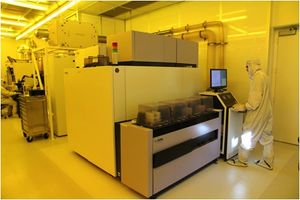Stepper 3 (ASML DUV): Difference between revisions
moved UCSB Test reticles to "Design & Fabrication Tools" section |
m →Design & Fabrication Tools: link to github repo |
||
| Line 66: | Line 66: | ||
*[[ASML 5500 Mask Making Guidelines|ASML 5500 Mask Making Guidelines]] - All the info you need to design and order a reticle for this system. |
*[[ASML 5500 Mask Making Guidelines|ASML 5500 Mask Making Guidelines]] - All the info you need to design and order a reticle for this system. |
||
*[ |
*[https://github.com/demisjohn/ASML_JobCreator ASML Job Creator] - Python scripts for generating ASML Job Files. |
||
*[[ASML Stepper 3 - UCSB Test Reticles|UCSB Test Reticles]] - Alignment Markers, Resolution Testing etc. |
*[[ASML Stepper 3 - UCSB Test Reticles|UCSB Test Reticles]] - Alignment Markers, Resolution Testing etc. |
||
Revision as of 20:55, 18 January 2020
| |||||||||||||||||||||
About
The ASML 5500 stepper is a 248nm DUV stepper for imaging dense features down to below 200nm and isolated line structures down to below 150nm. Overlay accuracy is better than 30nm.
The system is configured for 4” wafers and, with staff support, mounted pieces down to 14mm in size can be exposed using a 4” wafer as a carrier. The system is designed for high throughput, so shooting multiple 4" wafers is extremely fast. Additionally, exposure jobs are highly programmable, allowing for very flexible exposures of multiple aligned patterns from multiple masks in a single session, allowing for process optimization of large vs. small features in a single lithography.
The full field useable exposure area is limited to the intersection of a 31mm diameter circle and a rectangle of dimensions 22mm x 27mm. See the Mask Making Guidelines page for more info on exposure field sizes and how to order your mask plates.
Resists Used (see PhotoLith. Recipes for full process info):
- UV210-0.3 - Positive: 300nm nominal thickness
- UV6-0.8 - Positive: 800nm nominal thickness
- UV26-2.5 - Positive: 2.5um nominal thickness
- UVN2300-0.5 - Negative: 500nm nominal thickness
- DUV42P-6/DS-K101 - Bottom Anti-Reflective Coatings “BARC”
- PMGI/LOL1000/LOL2000 - Underlayers
AZ300MIF Developer for all processes
Process Information
- Process Recipes Page > "Stepper 3" - Established recipes and corresponding linewidths, photoresists etc.
- Sample size: 100 mm wafers with SEMI std. major flat
- Piece-parts process is possible but difficult - contact staff for info
- Alignment Accuracy: < 50 nm
- Minimum Feature Size: ≤150 nm isolated lines, ≤200 nm dense patterns
- Maximum Wafer Bow: approx. 100 µm. (4-inch diam.)
- Near this value, and the job may fail or lose the wafer inside the machine due to wafer vacuum error.
Operating Procedures
- Standard Operating Procedures
- Exposing wafers, loading reticles, focus/exposure matrix
- Job Programming - Full
- Job Programming- Simplified -Full Wafers
Troubleshooting and Recovery
- Error Recovery, Troubleshooting and Calibration
- Common errors/System Warnings, Wafer Handler Reset, System Calibration Verification
- ASML 5500: Recovering from an Error/Wafer Retrieval
- How to abort the job and recover your wafer.
Software Options
- Shifted Measurement Scans - better tilt/level measurements for edge-die.
- Compound Image Design - flexible Image Distribution: grouping of Images with shifts, duplicate instances of Images,
- Job Creator - create binary ASML job files from ASCII text files. Python scripting in progress.
Design & Fabrication Tools
- ASML 5500 Mask Making Guidelines - All the info you need to design and order a reticle for this system.
- ASML Job Creator - Python scripts for generating ASML Job Files.
- UCSB Test Reticles - Alignment Markers, Resolution Testing etc.
Service Provider
- ASML - ASML performs quarterly periodic maintenance and provides on-demand support.
